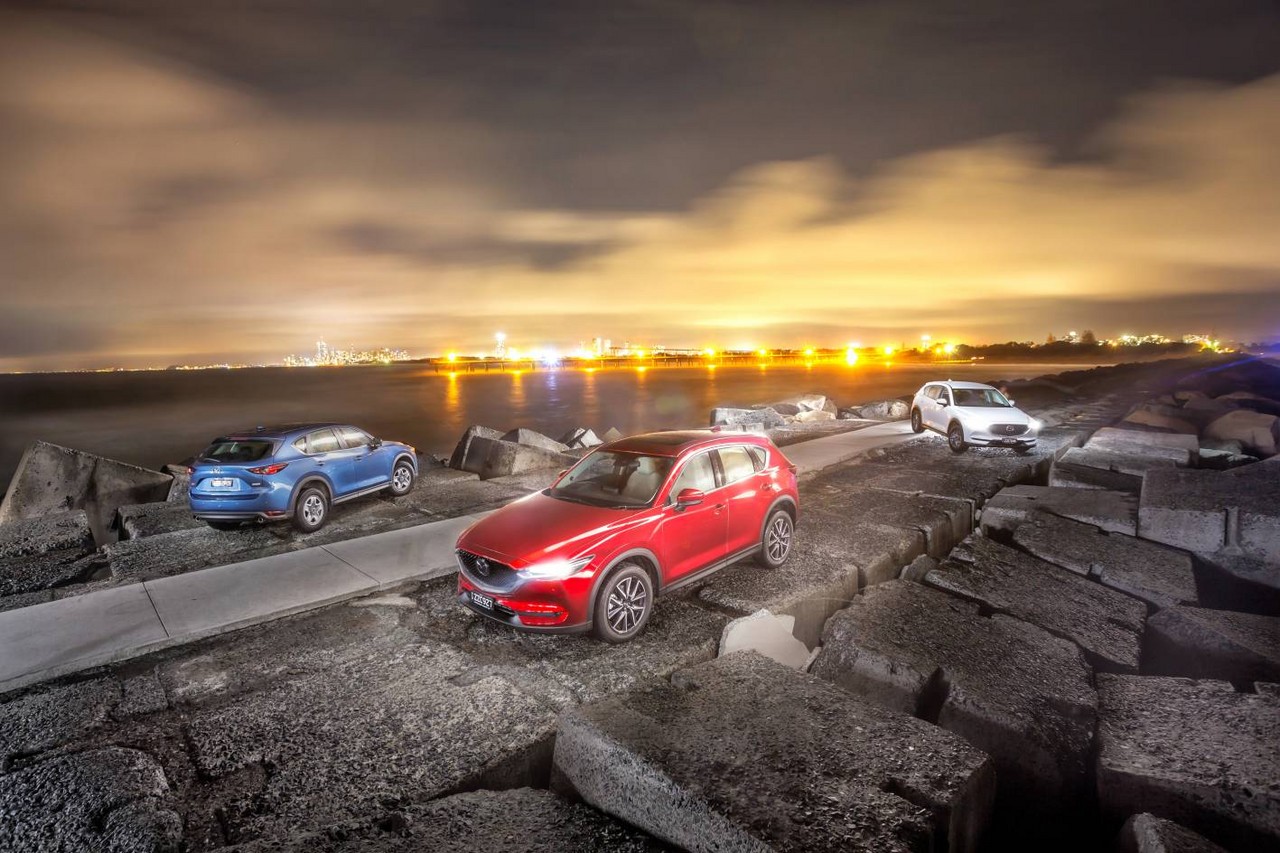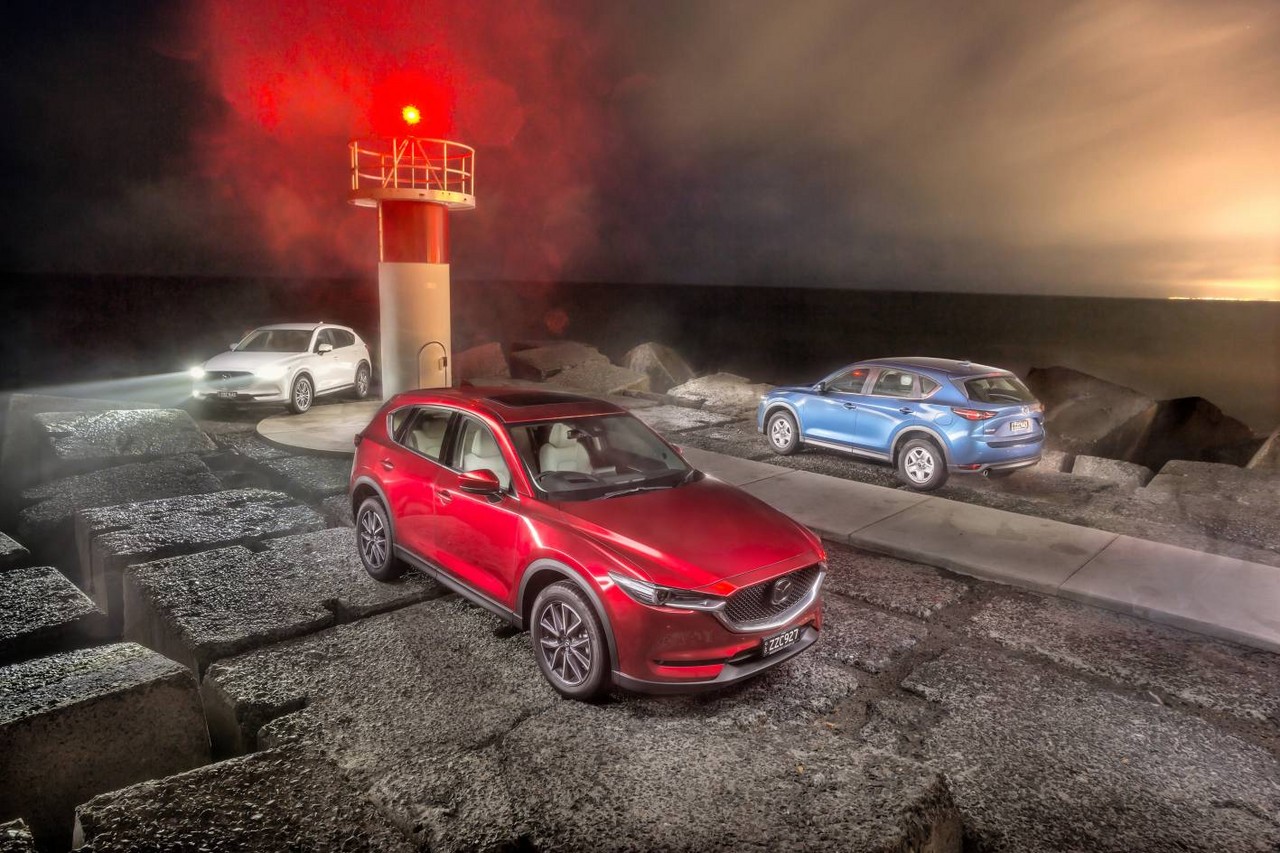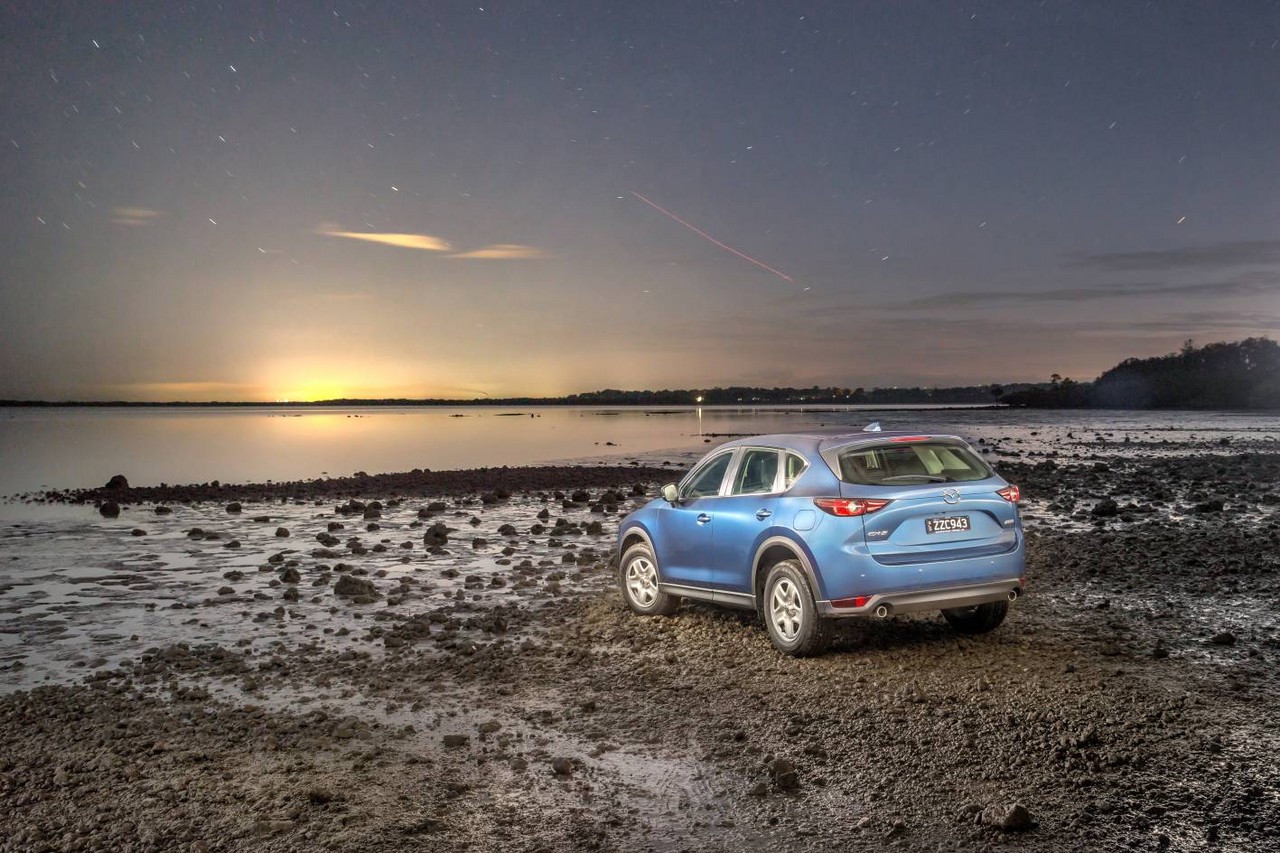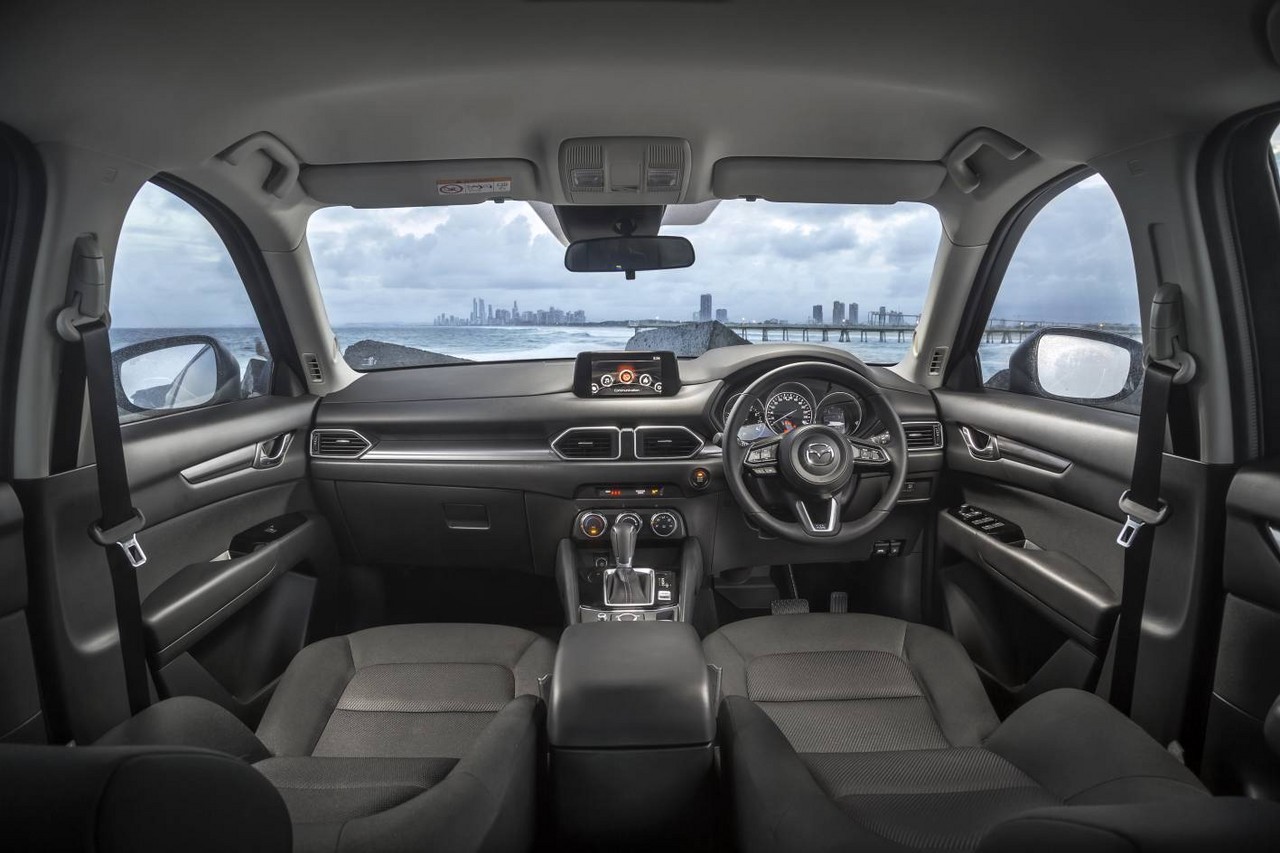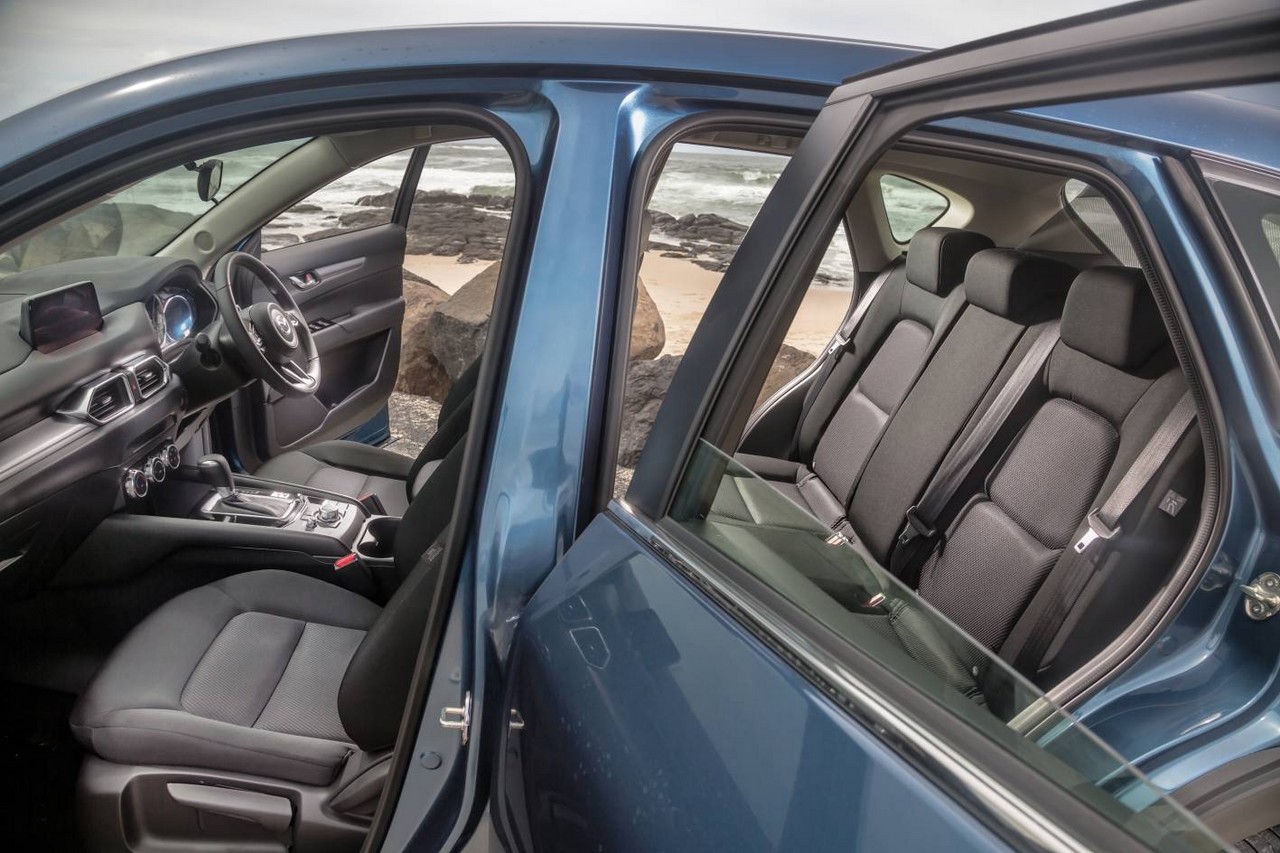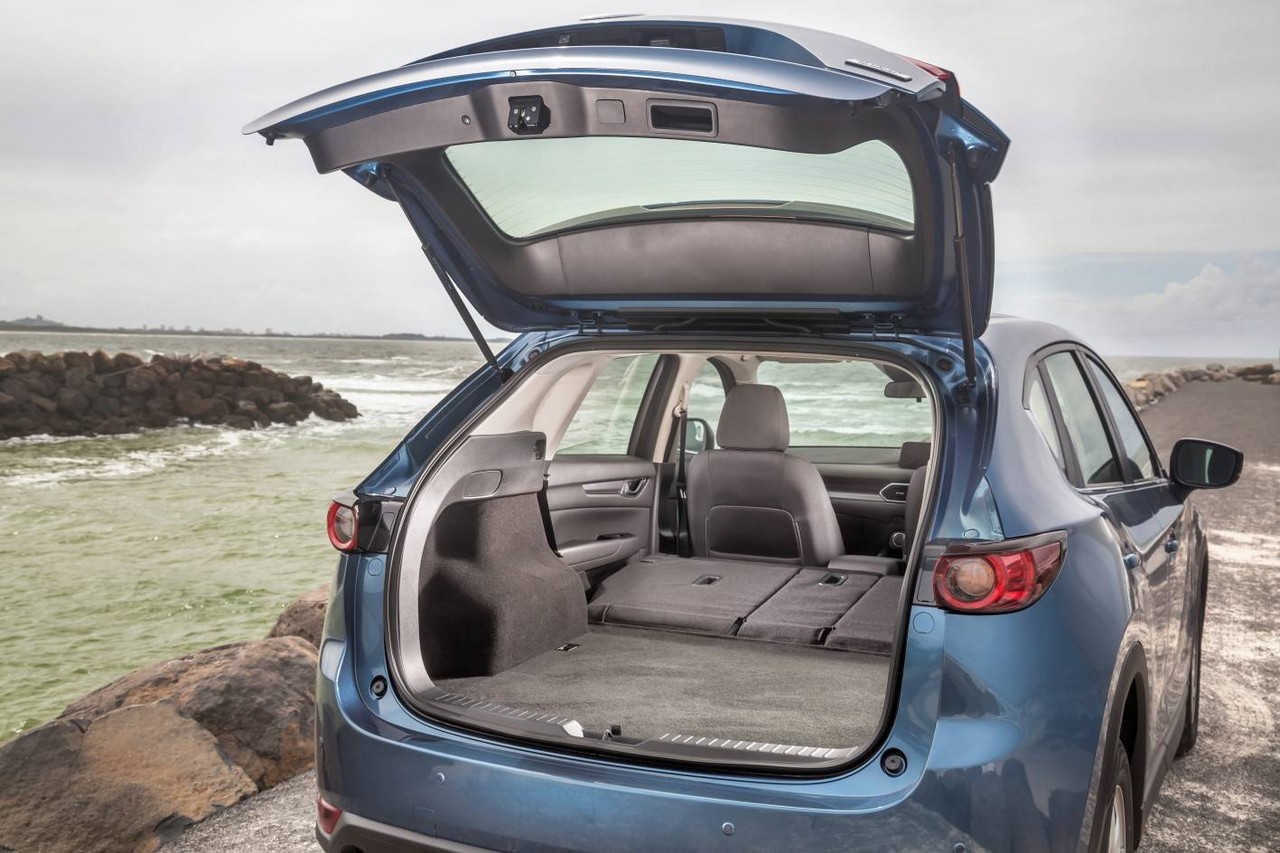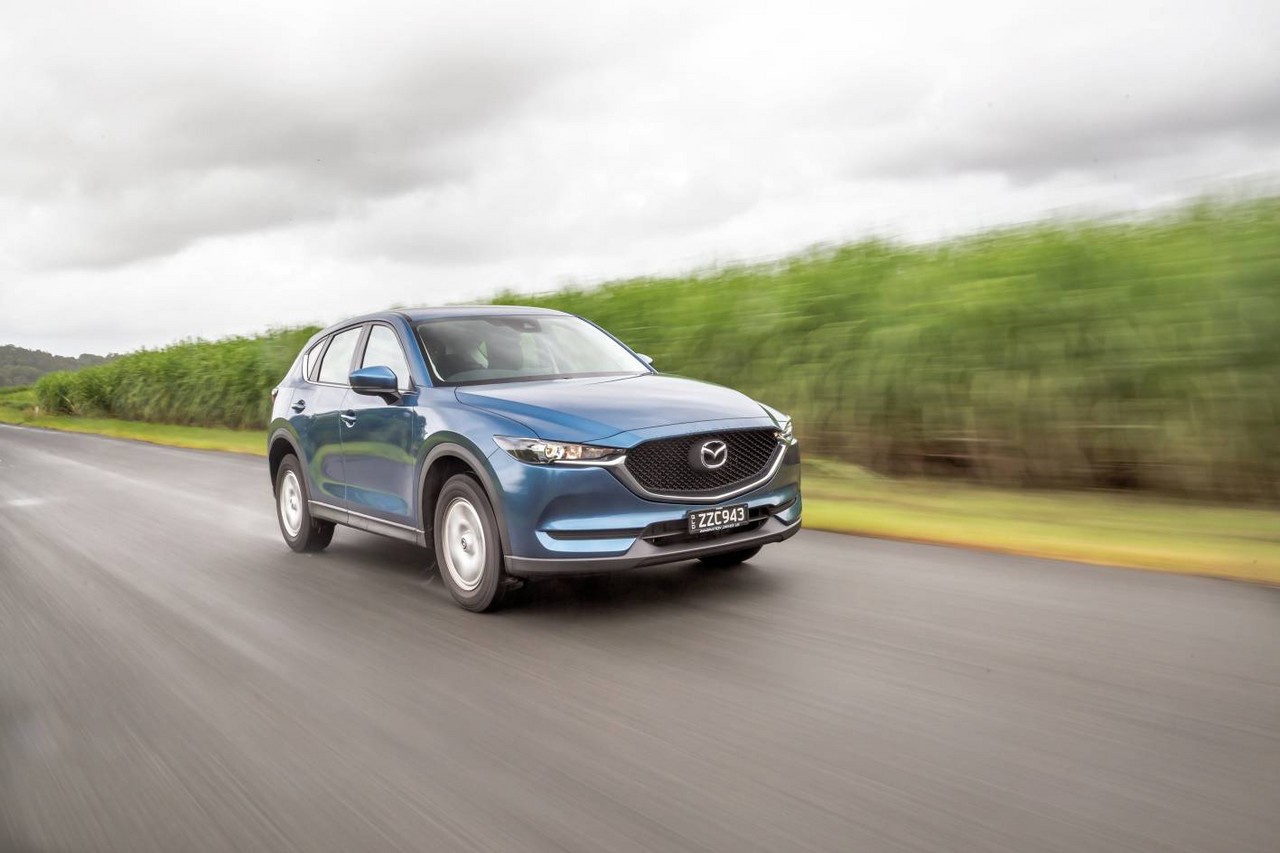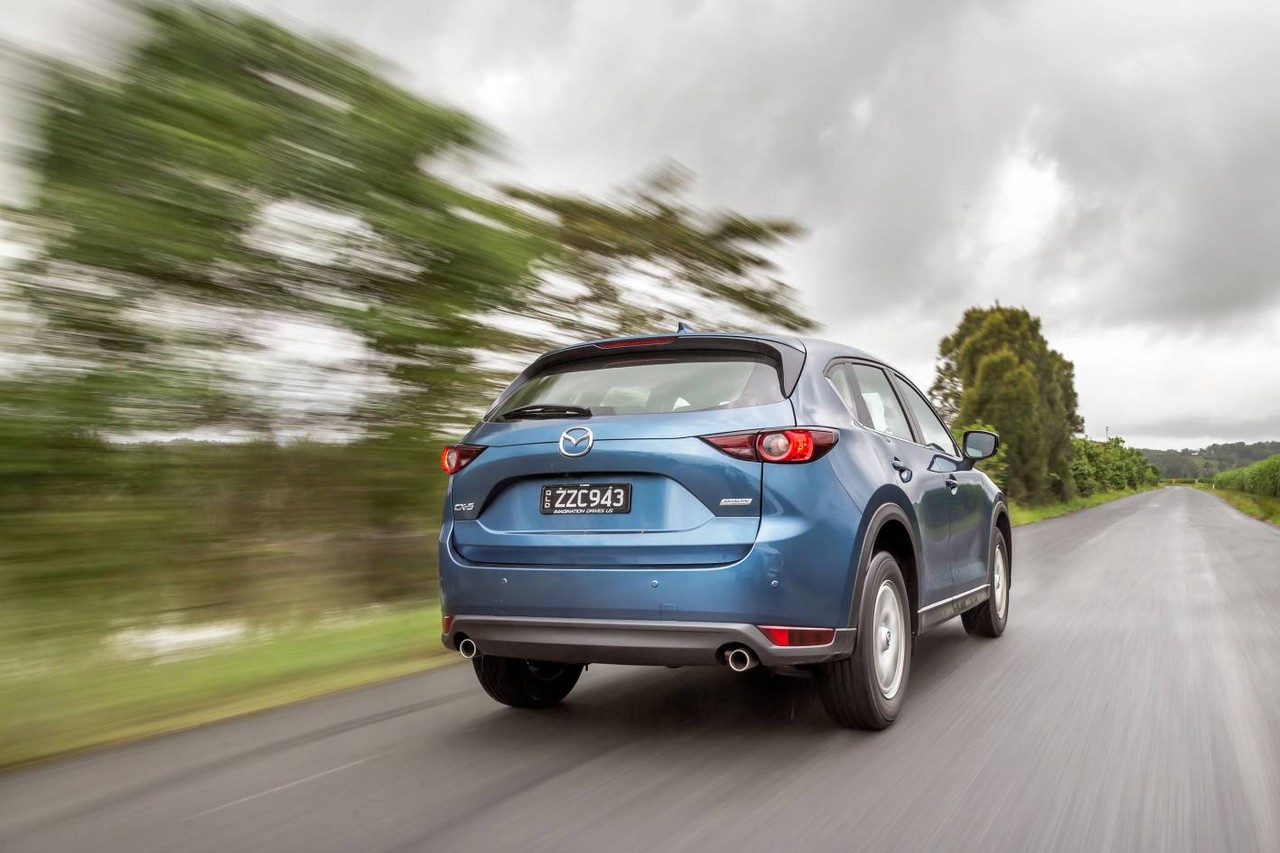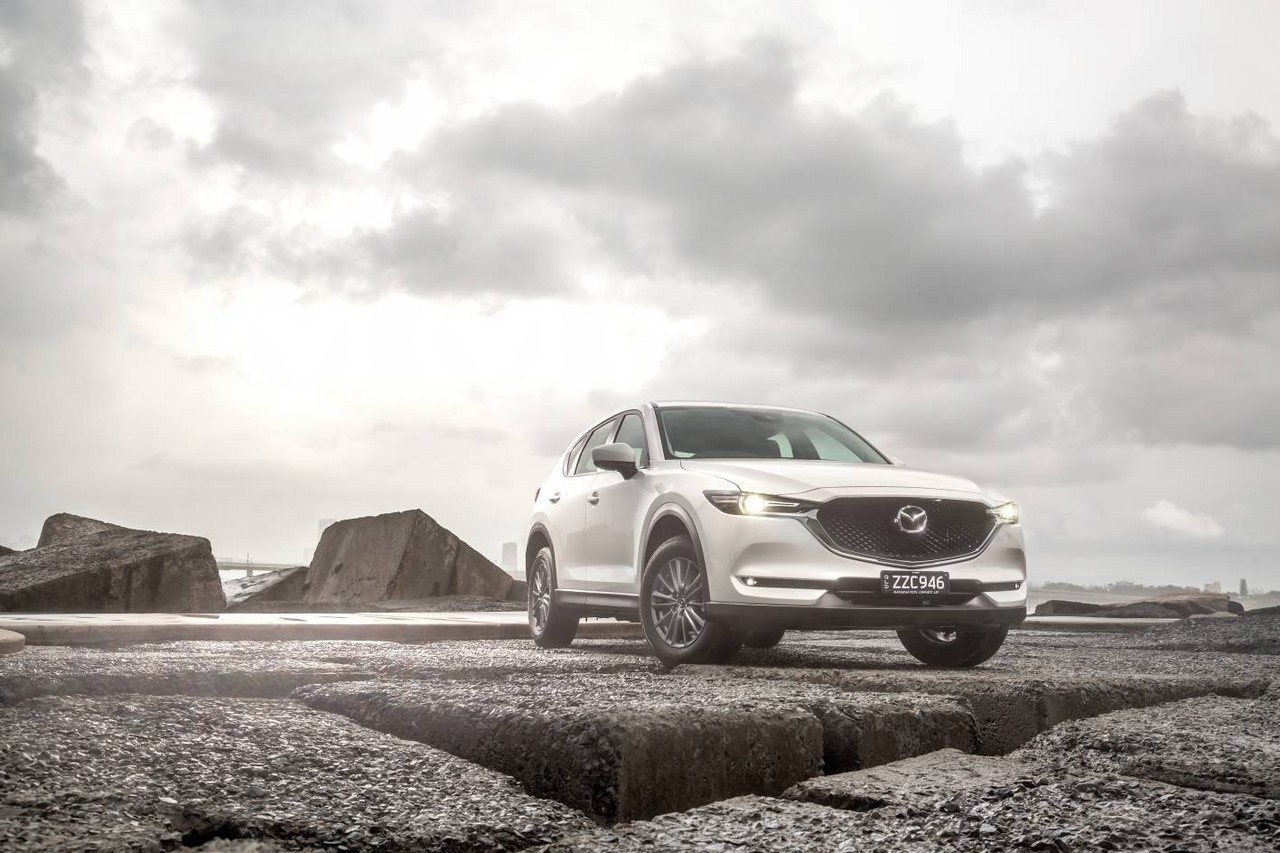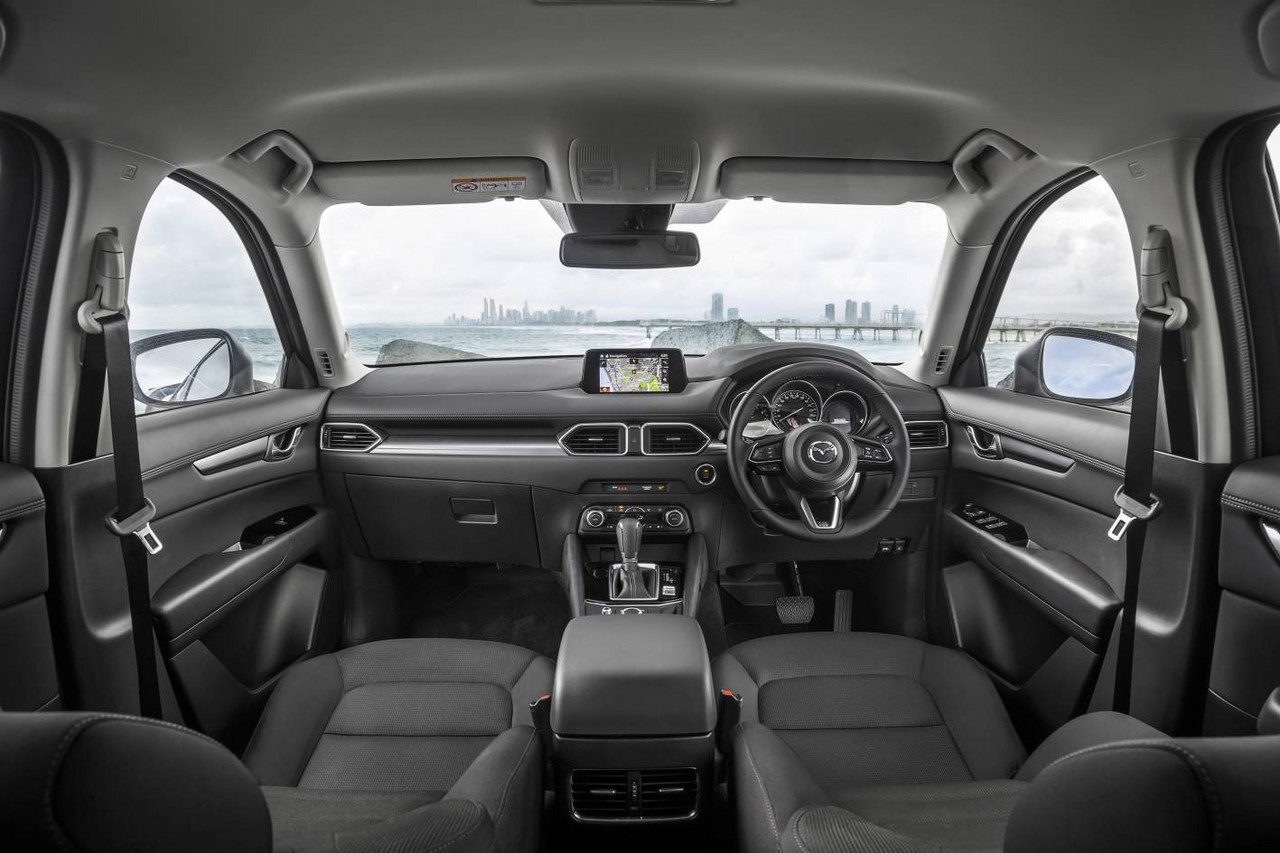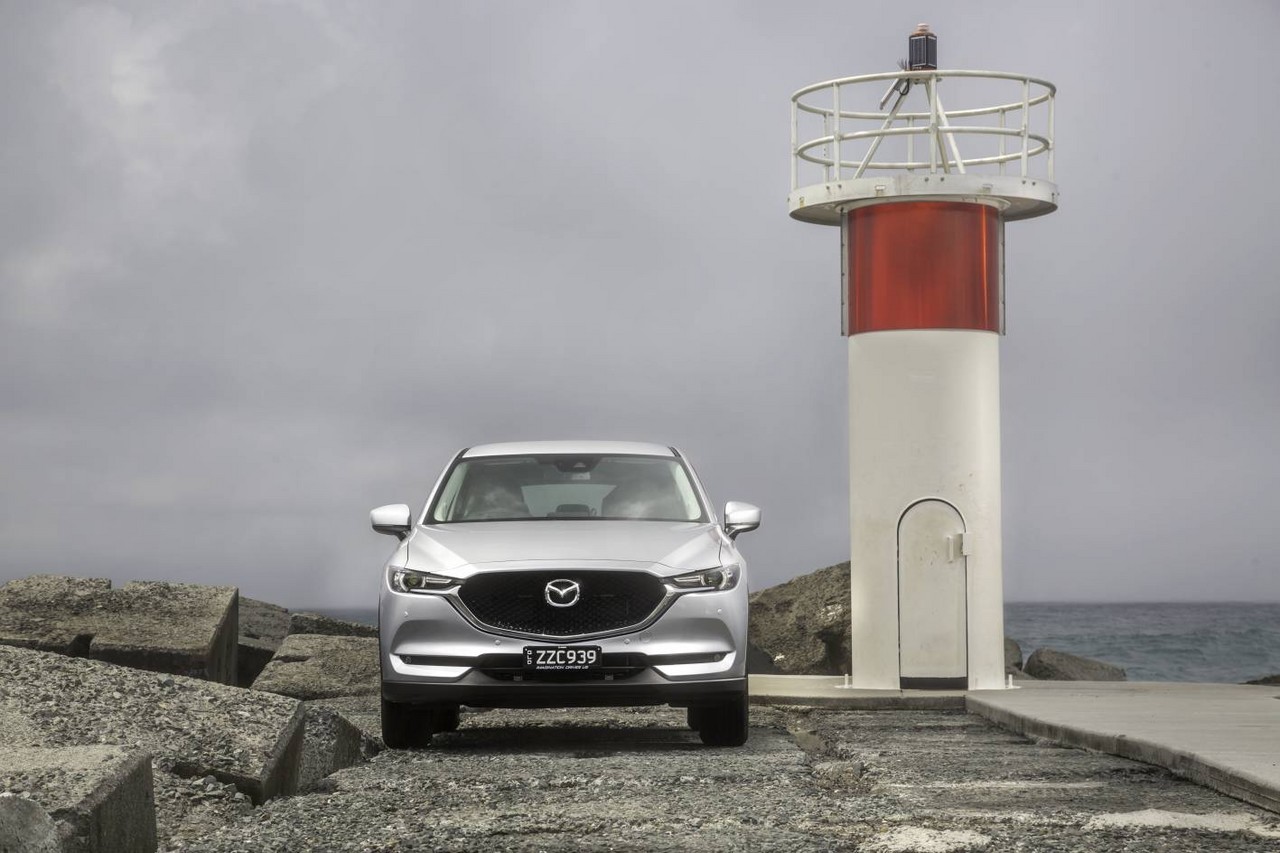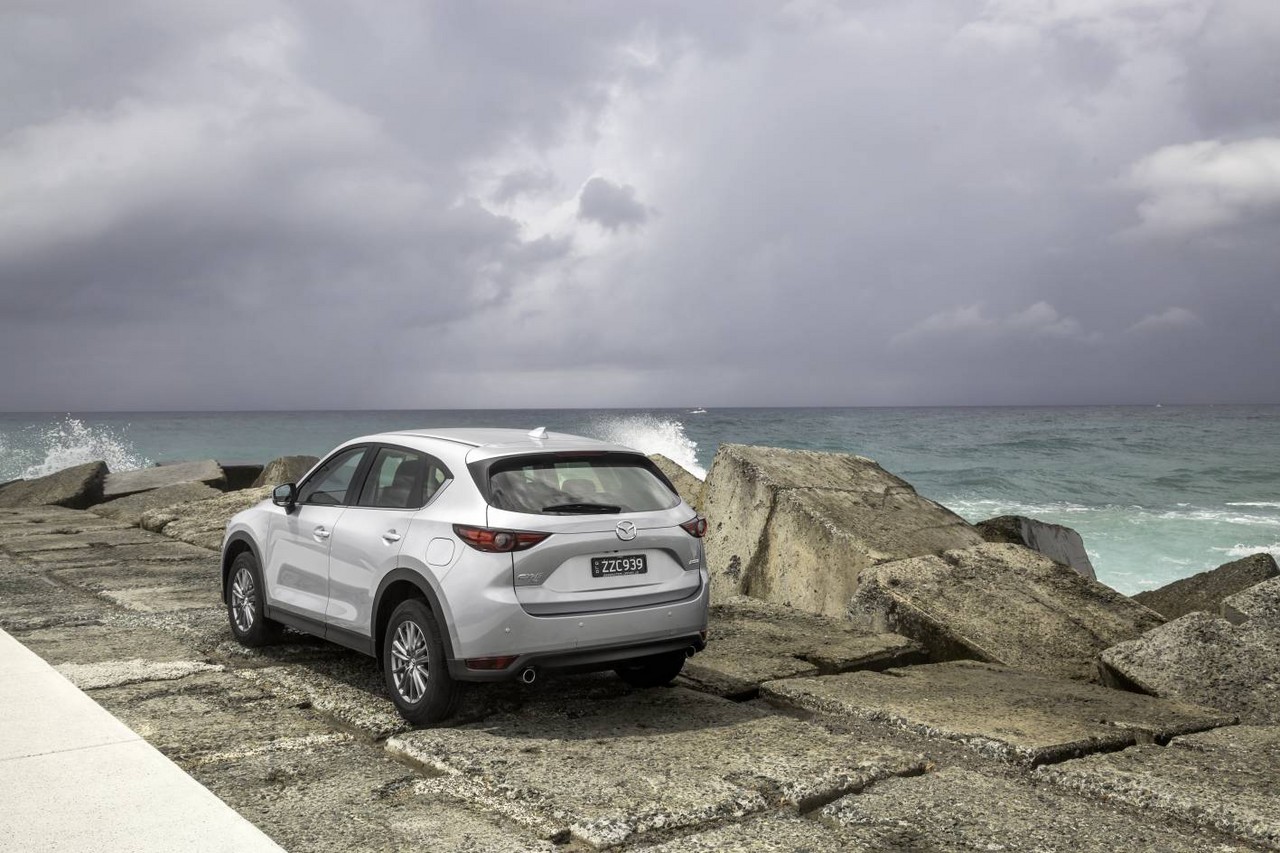
- Responsive 2.5-litre petrol and 2.2-litre diesel engines
- Autonomous emergency braking fitted as standard
- High standard of interior fit and finish
- Improved noise insulation relative to KE CX-5 predecessor
- Direct steering
- Impressive ride/handling balance…
- … but for CX-5 GT and Akera, 19-inch wheels and low-profile tyres hurt ride quality
- 2.0-litre petrol engine feels underpowered when vehicle is laden
- Less rear seat legroom and luggage space than rivals (see AD1 Tiguan , post-2012 CR-V and TL Tucson )
- No Apple CarPlay or Android Auto smartphone integration
Overview
Released in Australia in March 2017, the Mazda KF CX-5 was a mid-size SUV. Initially manufactured in Hiroshima, Japan, the Mazda KF CX-5 was offered with 2.0- and 2.5-litre naturally aspirated petrol engines, 2.2-litre twin turbo diesel engines (from May 2018) and 2.5-litre turbocharged petrol engines (from November 2018). For Australia, the Mazda KF CX-5 range consisted of Maxx, Maxx Sport, Touring, GT and Akera editions.
From October 2017, the KF CX-5 was manufactured at Mazda’s Hofu plant in Yamaguchi, Japan.
Engines
The 2.0-litre PE-VPS and 2.5-litre PY-VPR ‘SkyActiv-G’ petrol engines both had an aluminium alloy block and cylinder head, a balance shaft, double overhead camshafts, four valves per cylinder, variable valve timing for the intake and exhaust valves (Mazda’s ‘dual S-VT’), a 4-2-1 exhaust system with an extended manifold structure to reduce residual exhaust gas in the combustion chamber, a special piston cavity to reduce cooling losses, direct injection and compression ratios of 13.0:1.
The 2.2-litre SH-VPTR ‘SkyActiv-D’ diesel engine had an aluminium alloy block and cylinder head, double overhead camshafts, four valves per cylinder, common-rail direct-injection, a two-stage turbocharger with two turbines (a smaller turbine for low rpm and a larger turbine for more power when required) and a compression ratio of 14:1 (the world’s lowest for a diesel engine). For the Mazda KF CX-5, the SkyActiv-D engine also featured:
- Mazda’s ‘High-Precision DE Boost Control’ which provided more precise control of engine torque response by ‘optimising boost pressure control’ and enabling finer adjustment of fuel injection;
- Mazda’s ‘Natural Sound Smoother’ which sought to cancel piston vibration generated by extension and retraction of the connecting rod during combustion by placing a damper in the hollow part of the piston pin; and,
- Mazda’s ‘Natural Sound Frequency Control’ which reduced engine knock by controlling injection timing to within 0.1 ms so that engine vibration and structural vibration would cancel each other out, rather than combining.
May 2018: new engines
In May 2018, a new 2.2-litre biturbo diesel engine was introduced. Features of the new SkyActiv-D diesel engine included:
- A new two-stage twin turbocharger with variable geometry;
- ‘Rapid multi-stage combustion’;
- New pistons for stepped egg-profile combustion champers;
- ‘Ultra-high-response’ multi-hole piezo injectors with integrated i-ART sensors;
- A new water flow management system for faster warm-up; and,
- A higher compression ratio of 14.4:1 (previously 14.0:1).
From May 2018, the 2.5-litre SkyActiv-G engine had a cylinder deactivation that could reduce fuel consumption when driving at constant speeds. In light load situations, a switching mechanism in the hydraulic lash adjusters (HLA) of cylinders one and four could shut down those cylinders to reduce pumping losses and mechanical resistance. Furthermore, the 2.0- and 2.5-litre SkyActiv-G engines received the following updates:
- New and precisely tuned intake ports that produced a stronger tumble flow during the intake stroke for more rapid combustion;
- A re-shaped piston crown;
- Re-designed nozzles for the multi-hole injectors and increased injection pressure (30 MPa, previously 20 MPa) for a faster and more broadly dispersed spray;
- A new Water Flow Management (WFM) system which added a coolant control valve to reduce coolant flow around the combustion chamber walls during war-up;
- Asymmetrical oil rings which had a larger outer radius at the top and smaller radius at the bottom edge; and,
- Revised piston skirt curvature for an ‘ideal barrel shape’.
According to Mazda, these changes contributed to greater torque at low-to-mid engine speeds and improved fuel economy.
November 2018: 2.5 SkyActiv-G Turbo engine
From November 2018, the Mazda KF CX-5 GT and Akera variants were available with a 2.5-litre turbocharged petrol engine that was previously introduced in the Mazda TC CX-9 .
| Variant | Engine | Edition | Trans. | Peak power | Peak torque |
|---|---|---|---|---|---|
| SkyActiv-G 2.0 FWD (2017-18) |
1998 cc PE-VPS petrol I4 | Maxx | 6sp man. | 114 kW at 6000 rpm | 200 Nm at 4000 rpm |
| Maxx, Maxx Sport |
6sp auto | ||||
| SkyActiv-G 2.0 FWD (2018-on) |
1998 cc PE-VPS petrol I4 | Maxx | 6sp man. | 115 kW at 6000 rpm | 200 Nm at 4000 rpm |
| Maxx, Maxx Sport |
6sp auto | ||||
| SkyActiv-G 2.5 AWD (2017-18) |
2488 cc PY-VPR petrol I4 | Maxx, Maxx Sport, Touring, GT, Akera |
6sp auto | 138 kW at 5700 rpm | 250 Nm at 3250 rpm |
| SkyActiv-G 2.5 AWD (2018-on) |
2488 cc PY-VPR petrol I4 | Maxx, Maxx Sport, Touring, GT, Akera |
6sp auto | 140 kW at 6000 rpm | 251 Nm at 4000 rpm |
| SkyActiv-G 2.5T AWD (2018-on) |
2488 cc turbo petrol I4 | GT, Akera |
6sp auto | 170 kW at 5000 rpm | 420 Nm at 2000 rpm |
| SkyActiv-D 2.2 AWD (2017-18) |
2191 cc SH-VPTS biturbo diesel I4 | Maxx Sport, Touring, GT, Akera |
6sp auto | 129 kW at 4500 rpm | 420 Nm at 2000 rpm |
| SkyActiv-D 2.2 AWD (2018-on) |
2191 cc SH-VPTR biturbo diesel I4 | Maxx Sport, Touring, GT, Akera |
6sp auto | 140 kW at 4500 rpm | 450 Nm at 2000 rpm |
i-ACTIV AWD system
The Mazda KF CX-5 was available with Mazda’s ‘i-ACTIV’ all-wheel drive system, a pro-active (or predictive) system which AustralianCar.Reviews understands used two electro-magnetically controlled clutches that were mounted ahead of the rear differential. In normal conditions, the engine’s torque was primarily directed to the front wheels to minimise power losses and enhance fuel economy; ‘minute’ levels of torque, however, were sent to the rear axle to prevent backlash when additional torque was directed to the rear axle.
The i-ACTIV AWD system used twenty-seven (27) sensors to monitor driver behaviour and driving conditions, including:
- Vehicle speed;
- Accelerator position;
- Engine output;
- Acceleration and yaw;
- Steering angle and the electrical current of the steering system;
- Wheel slip;
- Gear selection;
- Brake fluid pressure;
- Road gradient; and,
- Ambient temperature and wiper operation (to determine if it was snowing or raining).
As a pro-active system, the magnetic clutches would engage when wheel slip was anticipated to direct torque to the rear axle, up to a 50:50 front:rear torque split. Furthermore, the i-ACTIV AWD command module calculated the desired front:rear torque split 200 times per second. To reduce friction, the AWD system used synthetic oil that maintained its low viscosity even in cold temperatures.
G-Vectoring Control (GVC)
Previously introduced on the Mazda GL Mazda6 , the Mazda KF CX-5 was equipped with Mazda’s ‘G-Vectoring Control’ (GVC) as standard. As the steering wheel was turned, GVC slightly reduced engine torque – usually by 0.01 g or less – to the front wheels to generate a small shift in load to the front axle. According to Mazda, this torque reduction improved cornering response by optimising the vertical load on each wheel.
In November 2018, G-Vectoring Control was replaced by G-Vectoring Control Plus (GVC Plus). When cornering, GVC Plus would apply light braking force to the outer wheels as the steering wheel returned to the centre position, providing a ‘recovery moment’ to restore the vehicle to straight line running. As such, the Mazda KF CX-5 would be more stable after initial emergency avoidance actions and when driving on slippery surfaces.
Body and dimensions
Compared to the Mazda KE CX-5 , the Mazda KF CX-5 was 10 mm longer (at 4550 mm) and 30 mm lower (1675 mm), though width (1840 mm) and wheelbase length (2700 mm) were unchanged; ground clearance was 185 mm when laden. Beyond the dimensions, the A-pillars for the Mazda KF CX-5 were re-positioned approximately 35 mm rearward to expand the driver’s field of vision, while other changes included:
- A ‘slightly lower’ beltline;
- The adoption of a single pane of glass for the rear window;
- A 10 mm wider front and rear track; and,
- Smaller door mirrors for enhanced ‘diagonal visibility toward the corners’.
Cargo capacity for the Mazda CX-5 was 442 litres with the rear seats in position (VDA method), though this increased to 1342 litres when the rear seats were folded down and cargo was filled to the roofline.
Significantly, the body of the Mazda KF CX-5 achieved a 15.5 per cent increase in torsional rigidity due to:
- The increased use of ultra-high-tensile steel, including 1180 MPa steel for the A-pillars and 980 MPa steel for the side sills and B-pillars;
- 2.0 mm thick apron gussets where the front suspension connected to the hinge pillars;
- Increasing the sheet thickness for the cowl member reinforcements, suspension housings and lower dash section to 1.2 mm (previously 0.8 mm);
- The adoption of closed cross-section side sill reinforcements;
- Larger gussets at the base of the A-pillars; and,
- The addition of a high-rigidity material to the cross-member brackets that joined the rear of the side sills to the sides of the body.
Like its predecessor, the Mazda KF CX-5 used 1800 MPa steel for the front and rear bumper reinforcements.
Suspension
The Mazda KF CX-5 had MacPherson strut front suspension and multi-link rear suspension. Changes for the front suspension, however, include increased diameter pistons for the front dampers and liquid-filled bushings that increased the damping effect in response to vibrations.
In November 2018, the following changes were introduced for the suspension:
- ‘Optimised’ outer ball joint location of the front knuckle to improve neutral steering characteristics;
- Thicker front stabiliser bar (from 22.2 mm to 23.0 mm diameter), softer front stabiliser bushings and thinner rear stabiliser bar (from 19.0 mm to 18.0 mm diameter) for greater response for the low g force range and stability at mid-to-high g forces; and,
- A revised valve structure for the front and rear dampers and the use of urethane for the rear damper top mounts to improve ride quality.
Steering
The Mazda KF CX-5 had rack-and-pinion steering with electric power assistance; its turning circle was 11.0 metres.
Safety equipment
Standard safety equipment for the Mazda KF CX-5 included dual front airbags, front side airbags, full-length curtain airbags, ABS, electronic brake force distribution, brake assist, electronic stability control, traction control, active front seat head restraints and front seatbelts with pre-tensioners and load limiters.
As standard, the Mazda CX-5 was equipped with the following active safety technologies –
- Smart City Brake Support (Forward/Reverse) with pedestrian detection (SCBS F/R): operating at speeds between 4 km/h and 80 km/h for vehicle detection and 10 km/h to 60 km/h for pedestrian detection, SCBS Forward used a near-infrared sensor that was mounted on the windscreen for ‘precision detection’ of objects up to six metres ahead of the vehicle. For SCBS Reverse, the system operated at speeds between 2 km/h and 8 km/h and used ultrasound sensors in the rear bumper to detect obstacles up to two metres behind the vehicle. When an obstacle was detected and a high risk of collision was assessed, the brakes would be applied automatically to avoid or reduce the severity of the collision (i.e. autonomous emergency braking or AEB);
- Blind Spot Monitoring (BSM): used radar sensors to detect vehicles approaching from behind the vehicle and in the driver’s blind spot. If the driver activated the indicators to change lanes while a vehicle was in the driver’s blind spot, the BSM system would flash a visual indicator in the respective door mirror and sound a buzzer; and,
- Rear Cross Traffic Alert (RCTA): as the vehicle was reversing, RCTA used the rear radar sensors to detect traffic that may cross the vehicle’s intended path. If detected, a visual indicator in the respective door mirror would flash and a warning tone would sound.
Beyond this, the Mazda CX-5 Touring, GT and Akera variants were further equipped with Traffic Sign Recognition (TSR) which could interpret road signs (such as speed limits, no entry and stop signs) and display this information to the driver on the Active Driving Display. If the driver exceeded the speed limit, TSR would warn the driver via blinking graphics on the display and sounding an alert.
The range-topping Mazda KF CX-5 Akera was distinguished by the following safety technologies –
- Smart Brake Support (SBS) with Forward Obstruction Warning (FOW): operating at speeds between 15 km/h and 160 km/h, SBS used a milliwave radar sensor and forward sensing camera to detect vehicles or obstacles on the road ahead. If a potential collision was assessed, an initial alert would sound (Mazda’s ‘Forward Obstruction Warning’) and the brakes would be pressurised. In its secondary phase, SBS would apply the brakes lightly. If a collision was assessed to be inevitable, SBS would increase braking force to minimise the severity of the collision. In the event that the driver applied the brakes, maximum braking force would be deployed;
- Mazda Radar Cruise Control (MRCC): operating at speeds between 30 km/h and 145 km/h, MRCC used a milliwave radar and forward camera to judge the relative speed of and distance to the vehicle ahead. In accordance with the target speed set by the driver, MRCC would adjust vehicle speed to maintain a safe following distance;
- Driver Attention Alert (DAA): operating at speeds above 65 km/h, the DAA system initially observes driver behaviour – such as steering wheel operation, vehicle speed and lane positioning – for 20 minutes to establish a benchmark. The DAA system then monitored driver behaviour for signs of fatigue and recommended rest breaks if detected. Furthermore, alerts were issued if the driver had been driving continuously for more than two hours; and,
- Lane-keep Assist System (LAS) and Lane Departure Warning (LDW): operating at speeds above 60 km/h, LAS used the forward-sensing camera to monitor lane markings on the road surface and assisted the driver to stay in their lane by providing steering torque assistance and steering wheel vibration alerts. The driver could also choose from ‘Early’ or ‘Late’ settings to adjust the level of assistance and the timing of its operation. In the ‘Early’ setting, for example, the system provided continuous steering assistance to keep the vehicle in the centre of its lane.
From November 2018, however, these previously CX-5 Akera-only safety technologies were fitted as standard throughout the Mazda KF CX-5 range.
Euro NCAP testing
In Euro NCAP testing , the Mazda KF CX-5 received a five star safety rating which included a 95 per cent adult occupant protection rating and an 80 per cent child occupant protection rating. In the frontal offset test, protection of the front occupants was generally rated as good, although chest and lower right leg protection for the driver was rated as adequate (i.e. a slight risk of serious injury). In the side impact and pole tests, driver protection was rated as good for all body areas.
Brakes and Auto-hold function
The standard brakes for the Mazda KF CX-5 were 297 mm by 28 mm ventilated front brake discs and 303 mm by 10 mm solid rear discs. The Mazda KF CX-5 2.2 SkyActiv-D, however, had 320 mm by 28 mm ventilated front brake discs.
The Mazda KF CX-5 was equipped with Mazda’s ‘Auto-hold’ brake function which kept the brakes applied after the driver lifted their foot off the brake pedal and only released them once the driver pressed the accelerator pedal. If desired, the driver could turn this function on or off using a switch on the centre console.
Features: Mazda CX-5 Maxx
Standard features for the Mazda CX-5 Maxx included 17 x 7.0J alloy wheels with 225/65 R17 102V tyres, ‘MZD Connect’ infotainment system with a seven-inch colour touchscreen, a six speaker sound system, digital radio tuner (DAB+), Internet radio integration, an auxiliary input jack (3.5 mm), USB input (iPod compatible), Bluetooth mobile phone connectivity and audio streaming, black cloth upholstery, air conditioning, cruise control, LED headlamps, rear parking sensors, a rear view camera, a leather-wrapped steering wheel and gearshift knob, 40/20/40 split fold rear seats, remote central locking, power mirrors with folding function, power windows, tilt and telescopic steering wheel adjustment, a height adjustable driver’s seat, push-button start, an electric parking brake, 12 volt power sockets (cargo area), a cargo cover, a trip computer and an immobiliser.
From November 2018, the Mazda KF CX-5 was fitted with Apple CarPlay and Android Auto smartphone integration as standard. Furthermore,
- The HVAC controls were relocated to a single climate control panel;
- The sides of the rotary switches featured a ‘finely textured surface’; and,
- White LED license plate illumination was introduced.
As standard, the Mazda KF CX-5 was fitted with a temporary steel wheel (17 x 5.5T with a 185/80 R17 tyre).
Features: Mazda CX-5 Maxx Sport
Compared to the CX-5 Maxx, the CX-5 Maxx Sport was further equipped with satellite navigation, dual-zone climate control air conditioning with rear air vents, LED front fog lamps, dusk-sensing headlights, rain-sensing wipers, an auto-dimming rear-view mirror and illuminated vanity mirrors.
From November 2018, the Mazda CX-5 Maxx Sport and Touring had a grey metallic finish for the 17-inch alloy wheels (previously dark silver).
Features: Mazda CX-5 Touring
Relative to the CX-5 Maxx Sport, the CX-5 Touring added combination black ‘Maztex’ and black suede upholstery, front parking sensors, heated door mirrors with automatic folding and a proximity key. The Mazda CX-5 Touring was also equipped with a flip-up ‘Active Driving Display’ which displayed information – such as vehicle speed, the speed limit and navigation directions – onto a transparent panel above the instrument binnacle.
In May 2018, the flip-up Active Driving Display was replaced by a head-up display that projected driving information onto the windscreen.
Features: Mazda CX-5 GT
Compared to the Mazda CX-5 Touring, the CX-5 GT was differentiated by its 19 x 7.0J alloy wheels with 225/55 R19 99V tyres, black leather upholstery, a ten-way power adjustable driver’s seat with memory settings, a six-way power adjustable front passenger seat, heated front seats, LED daytime running lights, power sliding glass sunroof and power-operated tailgate. The CX-5 GT also had:
- A 249 watt Bose sound system with ten speakers, Bose’s ‘Audio Pilot 2’ ambient noise compensation system and ‘Centerpoint 2’ surround sound;
- A head-up display that projected driving information onto the windscreen; and,
- Mazda’s Adaptive Front Lighting System (AFS) which would predict the vehicle’s direction – based on steering input and vehicle speed – and turn the headlights in that direction.
Features: Mazda CX-5 Akera
In addition to its safety technologies, the Mazda CX-5 Akera was distinguished by its:
- Side monitor: used a camera in the door mirror and displayed that vision on the central display so that the driver could see how close the vehicle was to kerbs or other obstacles; and,
- Adaptive LED headlights. The Adaptive LED headlights consisted of 12 blocks of LEDs which could be switched on or off independently. The Adaptive LED headlights had three functions:
- At speeds below 40 km/h, wide-range low beams would be used to light the area visible between the A-pillars and door mirrors;
- At speeds above 40 km/h, the forward-sensing camera would detect the headlamps of oncoming vehicles or tail-lamps of vehicles ahead; in response, the high beams would extinguish some of the LED blocks to prevent blinding the drivers of those other vehicles; and,
- At speeds above 95 km/h, the aim of the headlamps would automatically shift upwards to extend the range of coverage.
From May 2018, the Mazda CX-5 Akera was equipped with a 360-degree view monitor.
From November 2018, the Mazda CX-5 Akera featured Dark Russet Nappa leather trim, ventilated front seats, heated outer rear seats, a heated steering wheel, a seven-inch TFT LCD in the centre of the instrument cluster, ambient LED lighting, a frameless rear-view mirror and real wood for the dashboard and door inserts. The post-November 2018 CX-5 Akera also had a ‘brilliant dark’ finish for its 19-inch alloy wheels.
Brochure
